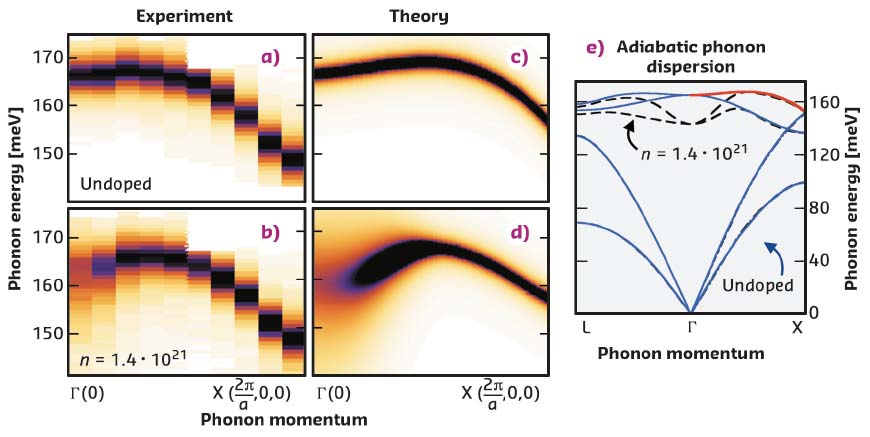- Home
- Users & Science
- Scientific Documentation
- ESRF Highlights
- ESRF Highlights 2017
- Electronic structure, magnetism and dynamics
- Non-adiabatic crystal-lattice dynamics in superconducting diamond
Non-adiabatic crystal-lattice dynamics in superconducting diamond
The crystal-lattice dynamics of superconducting diamond, investigated through ab initio calculations and inelastic X-ray scattering, has revealed the emergence of a non-adiabatic Kohn anomaly. This result constitutes the first observation of the breakdown of the Born-Oppenheimer approximation in the phonon spectra of a three-dimensional solid.
The Kohn anomaly (KA) is one of the most striking manifestations of the influence of electron-phonon coupling on the lattice dynamics of metals [1]. KAs result from the screening of lattice vibrations by virtual electronic excitations, and manifest themselves through distinctive dips in the phonon dispersion relations. The existence of KAs has been confirmed by inelastic neutron scattering experiments in a number of metals, conventional superconductors, as well as superconducting semiconductors. KAs are typically well described in the adiabatic Born-Oppenheimer approximation, whereby electronic and nuclear degrees of freedom are assumed to be decoupled. This picture breaks down whenever the electronic screening takes place on timescales that are comparable to the period of lattice vibrations. Correspondingly non-adiabatic effects may arise, leading to strongly coupled dynamics of electrons and nuclei, which signals a breakdown of the Born-Oppenheimer approximation. However, it has been suggested that non-adiabatic effects might be too small to be observable in three-dimensional solids [2].
The emergence of non-adiabatic effects in the Kohn anomaly of boron-doped diamond was investigated for hole densities that make the system superconducting at low temperature. The dispersion relations of the longitudinal-optical (LO) phonons (marked in red in Figure 96e) were analysed using state-of-the-art many-body first-principles calculations and inelastic X-ray scattering (IXS) measurements. IXS spectra were measured at beamline ID28. The phonon dispersions have been obtained entirely from first-principles through the evaluation of the phonon self-energy and the phonon spectral function based on the many-body theory of electron-phonon coupling. The measured IXS spectra are shown in Figure 96a and b as heat maps for pristine (undoped) diamond and for a boron concentration of 1021 cm–3 for momenta along the Γ-X direction. The computed phonon dispersions are reported in Figure 96c and d, whereas the full (adiabatic) phonon dispersions are shown in Figure 96e.
 |
|
Fig. 96: Measured IXS spectra for the LO phonon (marked in red in panel (e)) of pristine (a) and B-doped (b) diamond along Γ-X. The B-doping concentration n is in units of cm-3. c)-d) Non-adiabatic spectral function obtained from first-principles calculations. e) Adiabatic phonon dispersions. |
The IXS spectrum of B-doped diamond reported in Figure 96b exhibits a softening of the LO phonon energy by 7 meV as compared to the dispersion measured on the pristine sample and shown in Figure 96a. The softening is further accompanied by an increase of the phonon linewidth close to Γ in the doped samples. The softening and linewidth become more pronounced with increasing hole density. Calculations based on the adiabatic Born-Oppenheimer approximation, shown in Figure 96e, fail at reproducing these features: the phonon softening is overestimated by 300%, and linewidths may not be inferred at this level of theory. Conversely, the comparison between Figure 96a and b, and Figure 96 c and d, indicates that fully non-adiabatic calculations yield phonon energies and linewidths in excellent quantitative agreement with IXS. Besides resolving the long-standing discrepancy between earlier theoretical works and measured phonon dispersions, these results demonstrate a breakdown of the adiabatic Born-Oppenheimer approximation in the phonon dispersion relations of boron-doped diamond, and reveal that these effects may be sizeable also in three-dimensional bulk compounds.
The breakdown of the adiabatic Born-Oppenheimer approximation observed in the lattice dynamics of heavily boron-doped diamond may be explained by considering the timescales involved: while LO phonons oscillate with a period τph = 25 fs, the timescale of electronic screening τs is set by the plasma frequency ωpl via τs = 2π/ωpl, which, for a doping concentration of 1.4·1021 cm–3 corresponds to τs = 4 fs. As screening operates on timescales that approach the characteristic phonon period, the assumptions underlying the Born-Oppenheimer approximation cease to hold, and we see the emergence of strong non-adiabatic coupling.
In summary, by combining first-principles calculations of the electron-phonon interaction and high-resolution IXS experiments, the emergence of a non-adiabatic KA in superconducting diamond was demonstrated, and it was shown that a breakdown of the Born-Oppenheimer approximation may lead to sizeable renormalisation effects in the phonon dispersions of three-dimensional crystals. The results call for a systematic investigation of non-adiabatic effects and Kohn anomalies in the phonon dispersions of three-dimensional crystals such as doped semiconductors and transition metal oxides, and their implications on the superconducting properties of these systems. The combination of high-resolution IXS spectroscopy as provided by the ID28 beamline and state-of-the-art ab initio many-body methods offers unique opportunities to explore these and other exciting new directions in the areas of crystal lattice dynamics and electron-phonon interactions.
Principal publication and authors
Non-adiabatic Kohn Anomaly in Highly-Doped Diamond, F. Caruso (a,b), M. Hoesch (c), P. Achatz (d), J. Serrano (e), M. Krisch (f), E. Bustarret (d) and F. Giustino (a). Phys. Rev. Lett. 119, 017001 (2017); doi: 10.1103/PhysRevLett.119.017001
(a) University of Oxford (UK)
(b) Humboldt-Universität zu Berlin (Germany)
(c) Diamond Light Source (UK)
(d) Université Grenoble Alpes (France)
(e) Yachay Tech University (Ecuador)
(f) ERSF
References
[1] W. Kohn, Phys. Rev. Lett. 2, 393 (1959).
[2] A. M. Saitta, M. Lazzeri, M. Calandra, and F. Mauri, Phys. Rev. Lett. 100, 226401 (2008).



